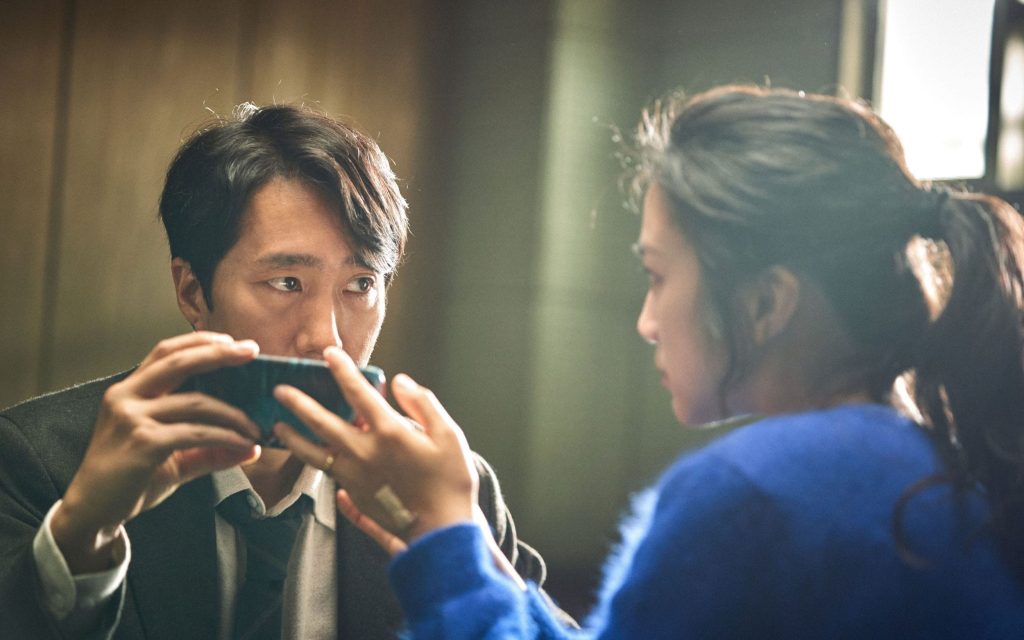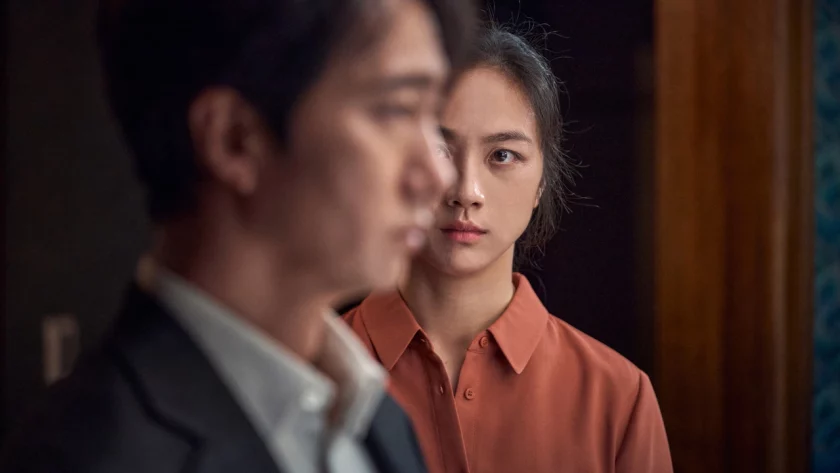BFI’s London Film Festival is in town! The FilmSoc Blog is back for the 66th edition of the city’s largest film festival, delivering a look at the hits and misses of the 2022-23 season.
◯ Warning: this review contains spoilers.
A twisted police procedural thriller about an insomniac detective and a recently-widowed Chinese immigrant— what if I told you that this is the premise for the most aching love story I’ve seen this year?
Park Chan Wook’s newest neo-noir mystery, Decision to Leave (Heojil Kyolshim), caught me off guard in every way imaginable. The film opens with Det. Hae-jun (Park Hae-il) opening a new investigative case, looking up the peak of a mountain with a dead climber at his feet. The case is followed up with the newly-widowed climber’s immigrant wife, Seo-rae (Tang Wei) as the main suspect of the investigation. Hae-jun peering into her personal life for clues. With a fairly simple premise, the beauty of Decision to Leave lies in its details. Park’s master craftsmanship in blending cinematography, editing and the film’s script together come into full play as the film delivers an intense 138 minutes that you can’t peel your eyes or heart away from.

From their very first encounter, Hae-jun and Seo-rae are like two puzzle pieces that fit perfectly together. Their first encounter sees Hae-jun and Seo-rae packing away their take-out sushi boxes in complete silence. The swift movement as Hae-jun stacks the empty plastic containers while Seo-rae discards the utensils and napkins is somehow more tantalising than any love scene ever shot. Park Hae-il and Tang Wei’s chemistry is the driving force of the film, with Tang Wei’s dual performance in Korean and Mandarin being my favourite of the year so far. There’s an alluring magnetism to their chemistry that seems almost masochist for the audience to enjoy. However, the individual characterisation of Hae-jun and Seo-rae are as fascinating as their roles as lovers. Hae-jun, an insomniac detective, finds torture in struggling to seek closure in his unclosed cases. His sharp, perspicacious detective mentality is put to the test with the mysterious Seo-rae. Having illegally moved to Korea and then marrying a Korean immigration officer, Seo-rae is introduced as Hae-jun’s enigma. Shifting between her at-times inarticulate Korean and fluent Mandarin, Seo-rae’s emotions are portrayed through Tang-wei’s facial expressions. The script’s tense, slow-burn pining is brought to life by their undeniable chemistry.

After having directed the flashy The Handmaiden (2016), a film that is the epitome of eroticism, and the narratively jarring Oldboy (2003), how is it possible that Decision to Leave is the film that struck me the most? The film’s cinematography, by Kim Ji-yong, work in extreme poetry with the film’s motifs as the recurring juxtaposition between the mountains and the sea perfectly encapsulate the core conflict of the film. The film starts off with a death by the mountains and an agonising death by the sea. Constructed by Park with the foundation of an old Korean pop song “Mist”, the film plays on the motif of vision throughout the film. With Hae-jun’s concerning dry eyes as a result of his insomnia, Seo-rae’s dress that seems blue but also green under certain lights, and the couple’s blurred perspectives when it comes to one another, Decision to Leave is a Hitchockian, Wong Kar-wai-esque ode to the fine line drawn between love and deception.
The film isn’t perfect. The final act seems to dial the slow-burn aspect up and reach for a more extreme conclusion that feels slightly undeserved; the film’s disjointed comedic editing is at times too distracting to fully commit to Park’s weaving of romance and tragedy. The incorporation of modern technology like smartphones and smart watches with hyper-smart shots takes away from the film’s poetic narrative, something that I wish was taken out from the film entirely. It attempts to be the most melodramatic melodrama of times but it isn’t so convincing with its continuous inclusion of GoPros.

The film’s transition from a police procedural, albeit not exactly a Whodunit, to a tragic love story is heightened by its immersive camerawork and editing. There’s a particular scene in the first act of the film where we see Hae-jun staking outside Seo-rae’s apartment at a rather ungodly hour at night. The camerawork ostensibly shows Hae-jun spying on Seo-rae as a detective, trying to look for any suspicious leads as a result of her rather passive and unfazed reaction to her husband’s shocking death. The camera takes us from Hae-jun’s binoculars and zooms into Seo-rae’s disconsolate routine of smoking, leaving her dinner of ice-cream out to melt, and crying herself to sleep on her living room sofa. The camera then lingers on Seo-rae, with the backdrop of her walls that are embedded with wallpaper mountains that resemble violent waves. There’s a second layer to the detective narrative here. As Hae-jun begins to insert himself into Seo-rae’s home and life, he loses all sense of himself. The portrait of their relationship starts off like a paced bottom-to-top climbing of a mountain, but ends like a violent crash of waves as their love for one another leads to a destructive conclusion for both characters.
Decision to Leave is subtle. It plants traces of forbidden love and self-destruction in every one of its images. The title itself- the kyolshim (directly translating to ‘Decision’ in English, but with a bit more force) to leave- is tied together with the final scene of the film. The film’s last shot, an aerial shot that zooms in and out of a character’s facial expression, perfectly mirrors the last lines of Jung Hoon Hee’s “Mist”:
Where did that person go? Open your eyes in the fog. Hide your tears (그 사람은 어디에 갔을까? 안개 속에 눈을 떠라. 눈물을 감추어라).
Decision to Leave is currently showing in cinemas. Watch the trailer here:




